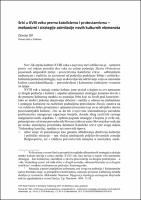Chapter Srbi u XVIII veku prema katolicizmu i protestantizmu – mehanizmi i strategije asimilacije novih kulturnih elemenata
| dc.contributor.author | Gil, Dorota | |
| dc.date.accessioned | 2022-06-01T12:10:00Z | |
| dc.date.available | 2022-06-01T12:10:00Z | |
| dc.date.issued | 2019 | |
| dc.identifier | ONIX_20220601_9788864539799_162 | |
| dc.identifier.issn | 2612-7679 | |
| dc.identifier.uri | https://library.oapen.org/handle/20.500.12657/55979 | |
| dc.description.abstract | The paper illustrates the similarities and differences in the strategies applied by the Orthodox Slavs to keep a connection with their basic code of (auto)-identification (i.e. Orthodoxy), as well as with the cultural tradition which was related to it. Particularly, the author focuses on the Serbs of the Habsburg Empire and the Protestant minorities who lived within the Hungarian borders during the 18th century, who were forced to develop some specific cultural strategies in order to offset the unifying tendencies and proselyting policy of the local Catholic Church. | |
| dc.language | Croatian | |
| dc.relation.ispartofseries | Biblioteca di Studi Slavistici | |
| dc.subject.other | Gerasim Zelić | |
| dc.subject.other | 18th century | |
| dc.subject.other | Serbian Orthodoxy | |
| dc.subject.other | Catholicism | |
| dc.subject.other | Protestantism | |
| dc.title | Chapter Srbi u XVIII veku prema katolicizmu i protestantizmu – mehanizmi i strategije asimilacije novih kulturnih elemenata | |
| dc.type | chapter | |
| oapen.identifier.doi | 10.36253/978-88-6453-979-9.03 | |
| oapen.relation.isPublishedBy | bf65d21a-78e5-4ba2-983a-dbfa90962870 | |
| oapen.relation.isbn | 9788864539799 | |
| oapen.series.number | 44 | |
| oapen.pages | 10 | |
| oapen.place.publication | Florence |

